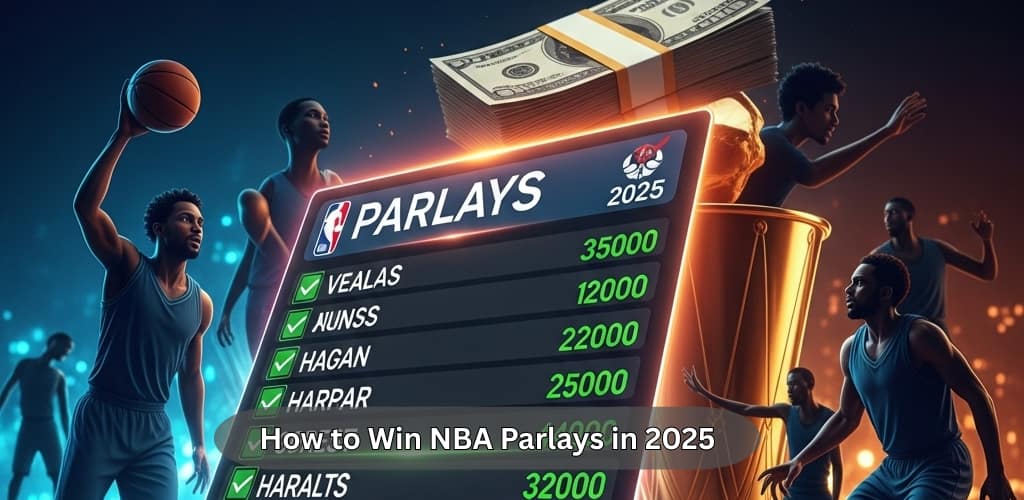Table of Contents
NBA parlays have become one of the most popular types of wagers because the league produces constant scoring swings, star-driven matchups, and nightly action. A single parlay ticket can tie multiple games together and turn a small stake into a strong return, which is why so many bettors start using them once they move beyond single-game wagers. The catch is that parlays are harder to win than straight bets. To cash them consistently, you need structure and a plan, not impulse betting.
Why Parlays Are So Common in NBA Betting
The NBA schedule creates a perfect environment for parlays. There are games almost every night and the market is full of lines that move quickly based on injuries, rest spots, or matchup edges. That volume gives you options. When you connect multiple outcomes, the payout increases because you are stacking probability. That is the appeal.
Bettors also enjoy the sweat of following multiple results on one ticket. A parlay keeps you invested in more than one outcome and makes every possession meaningful. The excitement is real, but the key to winning long term is understanding that excitement cannot replace sound betting logic.
How NBA Parlays Work
A parlay is a single wager that combines two or more separate bets. Every leg needs to win or the entire ticket loses. There is no partial payout if one game fails. The odds multiply, so the payout rises with each leg added.
For example, if you build a two-leg moneyline parlay with the Celtics and Nuggets, a $100 wager can return far more than it would on two separate bets. That is the math behind parlays. Higher risk, higher return. The problem is that every leg introduces another chance for failure. That is why the sharpest bettors prefer smaller, tighter parlays instead of chasing long lottery-style combinations.
Picking the Right Type of NBA Parlay
NBA parlays come in three main forms: moneylines, point spreads, and totals. Moneyline parlays are simple because you only need to pick the winner. Spread parlays reward a bit more insight, and totals parlays depend heavily on pace, efficiency, and matchup context.
In 2025, same-game parlays are one of the most common versions of this bet. They let you combine multiple events from the same matchup. If you think a game between Oklahoma City and Phoenix will be high scoring, you might parlay the over with a Shai Gilgeous-Alexander points prop and a Suns team total. Same-game parlays work best when the legs are correlated. If the scoring environment hits, several legs move with it.
Teasers as a Parlay Alternative
Teasers give bettors a way to adjust the spread or total in their favor. They operate like parlays because every leg must win, but you gain a cushion on each line. The tradeoff is a reduced payout.
If Minnesota is -5.5 against Portland and you move the line to -0.5 in a teaser, you do not need a margin of victory. You only need a straight win. You can pair that with a second game, like Milwaukee +4.5 teased up to +9.5 if you expect a competitive matchup. Teasers are useful in lower-variance games or when the market is tight around a key number. You sacrifice payout for insurance, which makes them appealing when one of your reads is strong but not blowout-safe.
Strategy and Risk Management
The biggest mistake bettors make with parlays is adding too many legs. Two or three is the sweet spot. Once you get to four or more, the probability curve works against you. Sportsbooks profit heavily from oversized parlays because most of them die on one unnecessary leg.
Bankroll structure matters as well. Parlays should not make up your entire weekly plan. They should supplement your card. If you normally wager $100 on a straight bet, a parlay might be $50 or $100, not a full-stack risk. The goal is controlled upside, not desperation betting.
Confidence should drive inclusion. If you would not wager that leg individually, it does not belong in the parlay. Every leg needs to be something you would stand behind on its own.
Betting with Correlation and Logic
The sharpest parlay bettors think in terms of game scripts. If you expect a defensive battle, pairing an under with player props that depend on pace does not make sense. All legs should tell the same story.
Correlation is the difference between betting with intention and playing blind combinations. NBA totals are often influenced by tempo and shooting efficiency. If you like a high-scoring spot, you look for props and sides that build on that same expectation. You are not guessing. You are aligning outcomes.
When to Pass on a Parlay
Sometimes the smartest move is not placing the bet. If the slate does not present a clean matchup edge or you are forcing a leg only to improve payout, passing protects your bankroll. The NBA season is long. There will always be another opportunity. Waiting for the right setup is part of winning over time.
Final Takeaway
Parlays are a fun and profitable part of NBA wagering when they are built with discipline. They reward timing, matchup awareness, and correlation. The more focused your card is, the higher your chance of cashing it. Teasers offer another path when you want better control over the number without losing the multi-leg format.
The more experience you gain, the more you learn to pick spots instead of forcing action. Winning NBA parlays is about clarity. Know your angles, stay within two or three legs, and let logic do the work.

